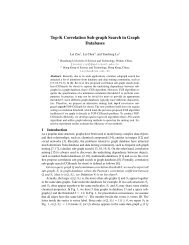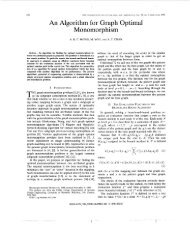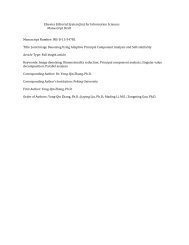PDF (1MB) - QUT ePrints
PDF (1MB) - QUT ePrints
PDF (1MB) - QUT ePrints
You also want an ePaper? Increase the reach of your titles
YUMPU automatically turns print PDFs into web optimized ePapers that Google loves.
28 · Alsayed Algergawy et al.<br />
(a) XML document (b) Level Structure (c) Level Edge<br />
Fig. 11: Example of Level Structure and LevelEdge.<br />
∑ m−1<br />
i=0<br />
Sim L1,L 2<br />
=<br />
c i × a m−i−1<br />
∑ M−1<br />
k=0 t k × a M−k−1<br />
where c i is the number of common distinct edges in the level i of L 1 and L 2 , while t k is<br />
the total number of distinct edges in the level k of both L 1 and L 2 , m = min(N 1 , N 2 )<br />
and M = max(N 1 , N 2 ). For heterogeneous XML documents, common edges in different<br />
levels should be identified and a similarity function similar to the one used in XCLS<br />
is used.<br />
—Clustering/Grouping. In this phase, a partitional clustering algorithm based on a modified<br />
version of k-means is used.<br />
—Evaluation Criteria. The quality of the XEdge system is only evaluated using the external<br />
criteria, such as precision, recall, and FScore. The experimental results show that<br />
both XEdge and XCLS fail to properly cluster XML documents derived from different<br />
DTDs, although XEdge outperforms XCLS both in case of homogeneous and heterogeneous<br />
XML documents. However, scalability of the approach has not been checked.<br />
6.1.3 PSim. Path Similarity (PSim) [Choi et al. 2007] proposes a clustering method<br />
that stores data nodes in an XML document into a native XML storage using path similarities<br />
between data nodes. The proposed method uses path similarities between data nodes,<br />
which reduce the page I/Os required for query processing. According to our generic framework,<br />
PSim presents the following phases.<br />
—Data Representation. XML documents are modeled as data trees, including both elements<br />
and attributes. No more normalization/transformation process is needed.<br />
—Similarity Computation. PSim uses the Same Path (SP) clusters, where all nodes (simple<br />
objects) with the same absolute path are stored in the same cluster, as the basic units for<br />
similarity computation. The PSim method identifies the absolute path for each SP cluster<br />
and then compares between SP clusters utilizing their absolute paths as identifiers. It<br />
computes the path similarity between every SP cluster pair using the edit distance algorithm.<br />
Given two absolute paths P 1 = /a 1 /a 2 .../a n and P 2 = /b 1 /b 2 /.../b m , the edit<br />
distance between two paths, δ(P 1 , P 2 ), can be computed using a dynamic programming<br />
technique. Using the edit distance between two absolute paths, a path similarity between<br />
two SP clusters sp 1 and sp 2 is computed as follows :<br />
ACM Computing Surveys, Vol. , No. , 2009.<br />
path similarity(sp 1 , sp 2 ) = 1 − δ(P 1, P 2 )<br />
max(|P 1 ||P 2 |)












